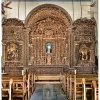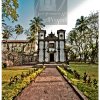Identification |
| Name |
Mónica Esteves Reis [Investigadora Doutorada] |
| Academic Degree |
3º Ciclo |
| Member Type |
Integrado Doutorado |
| Research Field |
Archaeology [Art History] |
| Links |
CV DeGois
|
| |
Research Project(s) |
| Project(s) |
De Portugal para a Índia - o percurso da arte retabular nos territórios da antiga Província do Norte e em Goa (Doutoramento financiado pela FCT) |
| |
Interests |
| Interests |
História da Arte, Arte Indo Portuguesa, Arte Indiana, Património Cultural, Arqueologia |
| |
Affiliation |
Identification |
| Name |
Mónica Esteves Reis [Investigadora Doutorada] |
| Main |
Universidade do Algarve |
| Other affiliations |
CHAIA - Évora |
| |
Contacts |
| Email |
monicaereis@gmail.com |
| Morada istitutional |
Centro de História da Arte e Investigação Científica Palácio do Vimioso, Largo Marquês de Marialva, nº8 7002-554 Évora Portugal Apartado: 94 |
| Personal webpage |
Personal Page |
| |
Publications |
| Name of Publication |
A Companhia de Jesus em Damão e o Retábulo de Nossa Senhora com o Menino (ver detalhe) |
| Publication type |
Artigo em revista |
| Referência Bibliográfica |
Reis, Mónica, "A Companhia de Jesus em Damão e o Retábulo de Nossa Senhora com o Menino". Revista de História de Arte e Arqueologia 11 (2009): 37-54 |
| Country |
BR |
| Sinopse em Português |
Enunciando a intenção de fé integrada no projeto expansionista português de D. Manuel
I, são traçados os perfis da Companhia de Jesus e a sua ação na Índia, mais precisamente
em Damão, onde se estabelecem após a doação da mesquita dos abexins, recém-conquistada
por D. Constantino de Bragança. Esta introdução histórica permite situar e integrar a temática
do retábulo inaciano que ainda subsiste em território damanense, apesar de redistribuído pelos
diversos espaços religiosos. Tomando como exemplo um retábulo do século XVII, iremos
verificar como se adaptou a arte retabular num território onde cultos e deidades, altares e
templos despontam entre as mais variadas e espetaculares formas de representação. (...) |
| Sinopse em Inglês |
Announcing the intention of faith in the D. Manuel I portuguese expansionist project,
the profile of the Society of Jesus and its action in India are drawn most precisely in the city of
Daman where they have settled after the donation of the abyssin mosque, newly conquered by
D. Constantino de Bragança. This historical note allows us to place and integrate the subject
of the ignatian retable still existing in damanese territory although it is spread throughout the
several religious places of Daman. Taking for example one retable of the 17th century we will
see how the retable art as adapted it self in a territory where cults and deities, altars and temples
flourish between the most diverse and spectacular forms of representation. (...) |
|
| Name of Publication |
O Retábulo Indo-Português de Damão e Diu (ver detalhe) |
| Publication type |
Artigo em revista |
| Referência Bibliográfica |
Reis, Mónica, "O Retábulo Indo-Português de Damão e Diu". Promontória 5 (2007): 271-98 |
| Country |
AF |
| Sinopse em Português |
O retábulo é a expressão máxima da demonstração da fé na arte, o livro
sagrado personificado na madeira, o veículo de conversão de fiéis que ao
chegar ao espaço oriental, viria a sofrer transformações artísticas, por vezes
profundas, fruto da miscigenação artística gerada pela riquíssima cultura hindu.
A incorporação dos valores hindus na temática cristã dá lugar a criações de
elevada mestria. (...) |
| Sinopse em Inglês |
not available |
|
| Name of Publication |
The Indo-Portuguese Retable: from Portugal to India, arts as a meeting-place (ver detalhe) |
| Publication type |
Artigo em conferências |
| Referência Bibliográfica |
Reis, Mónica,The Indo-Portuguese Retable: from Portugal to India, arts as a meeting-place. South Korea: Asian Scholars, 2009 [no prelo] |
| Country |
KR |
| Sinopse em Português |
não disponível |
| Sinopse em Inglês |
After the conquest of the first territories along the Indian coast, in the beginning of the sixteenth century, India-bound ships carried - alongside missionaries, reinóis, governors and goods for trade - the first retables to furnish the newly built churches. These retables were of engraved wood and often painted, and there are indications that many of them were influenced by Flemish and Brabantish styles. Through existing documentation, we known of the "existence of some [retables] already in Cochin in the year 1511. Further documentary references (...) mention paintings which existed in churches much earlier, and others which the religious orders asked to be sent from Portugal. These works differ from those built in Goa, not only in terms of style but also wood quality. (...) |
|
| Name of Publication |
O Retábulo Indo-Português e a Miscigenação Iconográfica (ver detalhe) |
| Publication type |
Artigo em conferências |
| Referência Bibliográfica |
Reis, Mónica,O Retábulo Indo-Português e a Miscigenação Iconográfica. Lisboa: Fress, 2009 [no prelo] |
| Country |
AF |
| Sinopse em Português |
O retábulo Indo-Português das regiões da antiga Província do Norte e dos territórios de Goa é ainda para a história da arte um objecto que encerra em si muitos segredos, simplesmente porque o seu estudo não foi estabelecido e aprofundado, de forma a se determinarem os intercâmbios culturais na génese da sua execução artística. Num território onde cultos e deidades, altares e templos despontam entre as mais variadas e espectaculares formas de representação, a iconografia religiosa cristã enfrentaria um desafio que perpassava a própria lei de Roma. Num panorama em que a iliteracia católica prevalece, a arte religiosa surge como catalisador da fé mostrando nas imagens os benefícios da conversão sendo o retábulo o seu veículo principal. O retábulo é nesta perspectiva o representante da fé pela arte, o livro em imagens. As várias realidades aqui enunciadas conjecturaram a espectacularidade na representação: na fauna, animais fantásticos em substituição dos animais bíblicos, na flora, uso predominante da flora local e em geral transmutações que só são entendíveis tendo em conta a historicidade religiosa dos povos que se queriam cristianizados. O trabalho de investigação inserido no programa para doutoramento , bem como o trabalho anterior que conduziu ao grau de licenciatura , tem vindo a desvendar esses segredos e a mostrar as relações artísticas entre artistas do reino e artistas locais (...) |
| Sinopse em Inglês |
not available |
|
| Name of Publication |
Retable art in India: its importance, the empathic apathy and the future. Cultural aspects concerning conservation (ver detalhe) |
| Publication type |
Artigo em conferências |
| Referência Bibliográfica |
Reis, Mónica,Retable art in India: its importance, the empathic apathy and the future. Cultural aspects concerning conservation. Évora: Green Lines Institute, 2010 |
| Country |
PT |
| Sinopse em Português |
não está disponível |
| Sinopse em Inglês |
Due to a combination of cultural factors and the lack of specific studies, retable
art in India is slowly being neglected, forgotten and distorted, leading to a situation in which it
is vanishing day by day. Actions to prevent its total dilapidation cannot be reduced to specific
studies, which ultimately, will only prevent the total dilapidation of its memory. Portuguese India
is long gone and, with it, its features in art are simply being buried along with the past generations.
Politics are a double-edged sword acting both for and against culture and art. What are
the reasons for this loss of Indo-Portuguese retable art? And will knowledge of these reasons
help us establish a prevention plan to save retable art? Could India be a partner to save miscegenized
Indo-Portuguese Christian Art, an expression of two cultures? What is the future of Christian
retable art in Hindu India? This essay is a reflection on past and present history with a view
to bring about the subject on modern retable art conservation. (...) |
|
| |
Galeria |
| |
    |











